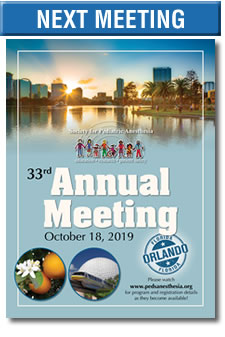SPA Meeting Reviews
Friday Session II: Opioids 2 – Practicalities and Perspective
Review by Steven M. Auden, MD
Norton Children’s Hospital
Linda Mason, MD, FASA (Loma Linda University), the “first board-certified pediatric anesthesiologist and third female” president of the American Society of Anesthesiologists (ASA) opened the session with a rapid-fire rundown of a multitude of issues being tackled by the ASA. Many of those issues are of great import to the pediatric anesthesia community. Relative to the session, she detailed ASA efforts to spread the word on opioid issues, including the very important adolescent issues mentioned in Session I. She also asked that drug shortages be reported to the ASA in order that they can have better information when lobbying on our behalf. The available-from-the-ASA and ASA-produced coloring book for kids and the Q&A book for parents were also mentioned.
Peter Davis, MD (Children’s Hospital of Pittsburgh) then took the podium with an abridged history of pediatric anesthesia with particular focus on opioids: As the Pendulum Swings: A Longitudinal Perspective on the Opioid Crisis. He began with a reminder that the road to hell (is) paved with good intentions, recalling the history of a time when pain was undertreated, leading up to the 2001 JCAHO mandatory assessment of and treatment of pain as a standard of care. He traced much of the more recent history of pediatric anesthesia including changes in techniques, changes in the opioids used, and history of our awareness of the dangers of anesthesia. He paraphrased Beecher and Todd’s lesson that in the 50s “more people died from anesthesia than from polio,” and gave a nod to Rackow and Salanitre for pointing out the higher risk for children compared to adults.
He went on to share a (perhaps apocryphal) tale of the anesthesiology resident in the heart room at the Mass General. This resident, responding to the command to give 10 of morphine, gave 10 cc of morphine. However, heart room morphine was 10mg/ml, not 1 mg/ml like everywhere else in the hospital. The resident was promptly bitten, beaten, and banished, never to be heard from again. After that, someone noticed that the patient was not breathing and suggested intubation. Intubation of the trachea proceeded and . . . nothing happened. Urinary catheter placement . . . nothing happened. Skin incision and . . . nothing happened. Sternotomy and, you guessed it – nothing happened. Thus began Lowenstein et al’s Cardiovascular Response to Large Doses of Intravenous Morphine in Man (N Eng J Med 1969; 281:1389-1393).
Dr. Davis then recounted some of the opioid research more specific to children, including contributions from Gregory, Hickey, Greeley, Davis, Freisen, and Anand. He went on to focus on the questions of whether or not intraoperative opioids increase post-operative opioid consumption. He balanced that against the reality that under-treatment of pain post-op can lead to a chronic pain state (Fortier et al. J Pediatr Surg 2011; 46:1700-1705).
Dr. Davis concluded his talk with an appeal to “find the sweet spot.” We can advance toward that spot with understanding the dangers inherent in as well as the benefits of opioids. We will then avoid knee-jerk administration of opioids and similarly avoid the under-treatment of pain post-operatively.
Peggy McNaull, MD (University of North Carolina) then took the stage to discuss Practical Opioid Stewardship: What is a Pediatric Anesthesiologist’s Role in the Opioid Crisis? Objectives of her talk included not only understanding the scope of the epidemic and the risks of persistent use of opioids after surgery, but even more importantly learning what one can do to help!
Dr. McNaull made a passionate and moving presentation. She revealed first that drug overdose is the #1 cause of death for Americans under 50 years old, and 70,237 died of overdose in 2017. In 2017, 11 kids died from it every day. Not only that, but 7% of high school seniors have misused an opioid other than heroin. The fact that over 191 million prescriptions for opioids are written each year helped make it clear where adolescent drug use starts: their own prescriptions or those of friends or family members.
Dr. McNaull went on to point out that three out of four heroin addicts began their use with prescription drugs (Jones CM. Drug and Alcohol Dependence. 2013). Even closer to home were the findings of Brummett et al (New Persistent Opioid Use after Minor and Major Surgical Procedures. JAMA Surgery 2017) that 6% of previously opioid naïve patients were still using opioids at 90 to 180 days. Persistent drug use was even higher after cancer-intended-as-curative surgery: 10.4% (Lee et al. Surgical Oncology 2017). Frighteningly, in previously opioid-naïve adolescents persistent drug use was 4.8% post op (Harbaugh et al. Persistent Opiod Use Among Pediatric Patients After Surgery. Pediatrics 2018).
The cost of the opioid epidemic is staggering. For each of the deaths above there are at least two hospitalizations, three ED visits, and 260 users. We have seen a 900% increase in Hepatitis C over 10 years, and a 922% increase in neonatal abstinence syndrome.
Dr. McNaull then transitioned to a detailed description of the work that goes into and the benefist coming out of a comprehensive opioid stewardship program. At UNC they now have Standard Opioid Prescription Schedule (SOPS) for 50 procedures including T&A (20 doses under 12, 30 over 12), laparoscopic appendectomy, circumcision, hypospadias repair, hernia repair, etc. Interestingly, systematically reducing prescribed opioid doses had no negative impact on patients’ pain experience post-operatively. Evidence that needed dose are still available but the over-prescription doses have been reduced. This program cut UNC’s opioid prescriptions from 1,288,401 doses in 2017 down to 886,550 in 2018.
Provider and patient education efforts were a huge effort and a huge piece of the success of this program. Safe storage and disposal, Resources are available at www.uncopioidsafeuse.org.
Dr. McNaull concluded her talk with a quote and a moving personal revelation. She quoted Maya Angelo: “Do the best you can until you know better. Then when you know better, do better.” She then revealed to us her very personal connection to the opioid epidemic: the loss of her younger brother.






